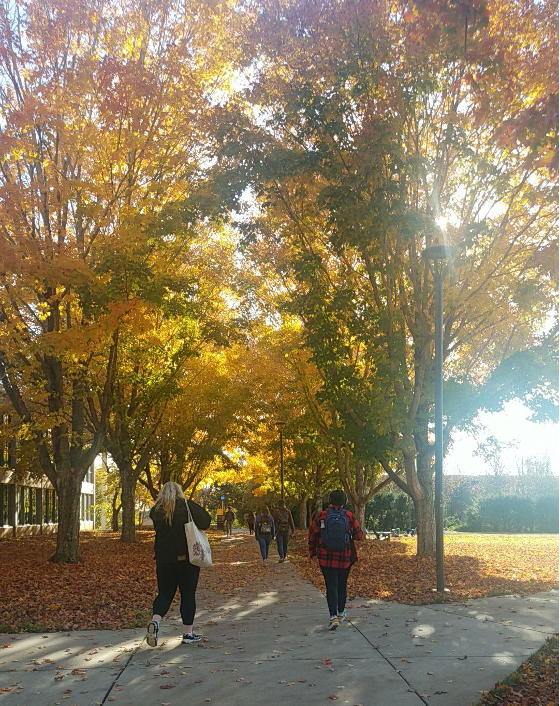Samantha Morin

UNCA students enjoy the fall foliage between classes in the fall of 2019
Contributor
[email protected]
The particular warmth of this season has pushed back the peak of the changing of the leaves significantly. The leaves are stubbornly green and there isn’t a fuzzy sweater in sight. This has also pushed back one of the events that UNCA students may look forward to the most.
After being held on a much smaller scale due to COVID-19 in the fall of 2020, the Turning of the Maples festival will be back as a large-scale event this year at UNCA.
“The event wasn’t canceled last year. We just held the event on a smaller scale. We hosted an unannounced event on the quad last year with cookies and cider packets so students could enjoy a little bit of Turning of the Maples while social distancing. We’re excited to be back with a full-scale event this year. Since this is such a beloved tradition on UNC Asheville’s campus, and especially with our alumni, we started the Turning of the Maples Virtual 5K to bring the tradition to bulldogs wherever they are,” said Colleen O’Neil, assistant director of alumni engagement at UNCA.
O’Neil said Turning of the Maples started at UNCA in 2006 by a group of students who wanted to build a new tradition on campus. There are many fun activities planned for this event from different student organizations across campus.
“Turning of the Maples is the annual UNC Asheville fall tradition where UNC Asheville students, faculty and staff gather on the Quad to enjoy the beautiful changing colors of the trees and maple cookies and hot apple cider, lawn games, painted pumpkins and live music performed by UNC Asheville students,” O’Neil said.
UNCA plans to host this year’s Turning of the Maples festival on Oct. 28 from 11 a.m. to 1 p.m. on the Quad to coincide with the peak of the changing leaves.
“I think our fall color development has been delayed somewhat by the recent warm weather. I think we have had good rainfall to keep the plants healthy, but the warm temperatures (especially warm nights) over the last couple of weeks have delayed color development. With the return of normal fall temperatures this weekend, I am hoping that color will start to develop, and we will have a good fall leaf color season,” Professor of Biology at UNCA Johnathan Horton, Ph.D. said.
Horton predicts leaf color at the highest elevations will be seen by mid-to-late September. In Asheville proper and surrounding lower elevations, peaking colors can be found throughout October and even well into November, depending on conditions.
“Plants respond to environmental cues like decreasing day length and temperature to initiate preparations for winter dormancy. As they begin this process, they will start to break down the chlorophyll in the leaves to recycle nutrients. This exposes the other pigments (carotenoids) that are orange and yellow. The bright red colors often seen result from anthocyanin production, which occurs best when we have bright sunny days and cool (but not below freezing) evenings. The plants photosynthesize during the day but can’t move the sugars out of the leaves at night – converting them to red pigments,” Horton said.
Horton also said if we have enough rainfall this autumn, not too much or not too little, the foliage should be beautiful.
“In the next month, we’re likely to have above-normal temperatures for October. Precipitation for the next month is likely about normal. Meteorologically, we’re expecting a near-normal rest of the month, which means temperatures in the 60s during the day and 50s at night,” said Christopher Hennon, Professor of Atmospheric Sciences at UNCA.
Hennon, who also specializes in climate change, said peak leaf time is different every year depending on the weather conditions that we face each fall. Peak is usually around late October.
“There’s been already a detectable lengthening of the warm season so the first freeze is happening later and later and then the last freeze is happening earlier and earlier. The warm season is getting longer,” Hennon said.

















